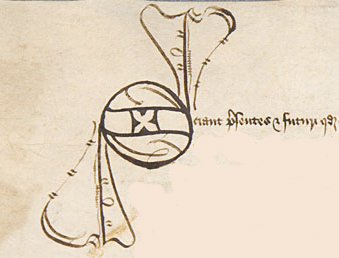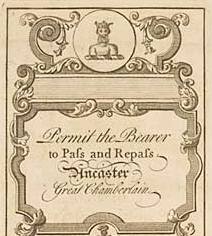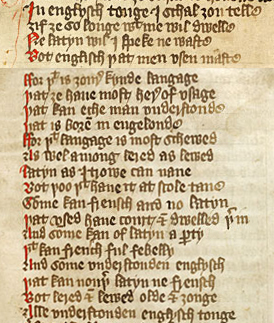Letter forms and abbreviations
Reading old handwriting is a challenge for most people. However, as we have seen, medieval scripts are usually written in a careful, regular hand. This means they can actually be easier to tackle than a personal scrawl of the nineteenth or twentieth century, if you have learnt a few basic hints and tips. On this page you will find lots of advice about unfamiliar letters, surprisingly-shaped letters, and abbreviations. If you want to know more, you can look at more comprehensive palaeography websites listed in the Further Reading page.
Recognising different letter forms
Here are four examples of exactly the same Latin phrase which commonly occurs in title deeds. The phrase is: ‘Sciant presentes et futuri quod...’ It means ‘Know all here present and to come, that...’
Can you make out the letters in these four examples, from 1230, 1317, 1388 and 1452?




The task is made a bit harder because the scribes liked to abbreviate long or common words.
For instance, the word ‘et’ (Latin for 'and') is never written out in full. Instead, the scribes use an abbreviation mark, just as we often use an ampersand (&) for ‘and’.
All of the scribes have abbreviated the word ‘presentes’, two of them have also abbreviated ‘futuri’, and three of them have abbreviated ‘quod’.
‘S’ and ‘F’
Now look closely at the second word in each example. The scribes never write out the letters ‘re’. The first letter ‘p’ is followed by a backwards loop which stands for ‘re’, and then by a long letter ‘s’ which looks in the first example a bit like a modern ‘l’, and in the others a bit like a ‘f’. In fact, you can see differences in the examples above between the ‘s’ in ‘presentes’ and the ‘f’ in ‘futuri’, if you look very closely.
‘s’ and ‘f’ can be very confusing if you are not used to reading old scripts. The long ‘s’ carried on being used in printing, even in the nineteenth century, and many people mis-read it as ‘f’ because they do not expect an ‘s’ to be formed in this way.
In the printed example below (Mol 266), the bearer is permitted ‘to Pass and Repass’ at the Duchess of Kingston’s public trial in 1766.

Look carefully at the words ‘Pass’ and ‘Repass’. They actually use two separate forms of the letter ‘s’, a long one first, and then a short one. This was very common. If you have ever been to Germany you might have seen a strange curly letter ß on street signs like Berlinstraße. This just stands for Berlinstrasse – the letter is a long and a short s, squashed together!
If you look back at the original examples, can you see instances of short ‘s’ being used as well as long ‘s’?
Archaic letters
In the Middle Ages, the English language included two letters derived from Anglo-Saxon, that are no longer in use:
- ‘yogh’ (ȝ) looks a bit like a ‘z’, and was used for a guttural-sounding ‘g’, ‘gh’ or ‘zh’. This letter helps to explain why the first name of the former Liberal Democrat leader Menzies Campbell is actually pronounced ‘Mingies’
- ‘thorn’ (þ) looks a bit like a ‘y’, or sometimes a ‘p’, but was pronounced ‘th’. This letter is the origin of the common mis-pronounciation of ‘Ye Olde Tea Shoppe’. It would not have been pronounced ‘Yee’, but simply ‘The’, because it is not a capital ‘y’, but a capital ‘þ’.
Both letters can be seen in the extract below:

Detail from Speculum Vitae, WLC/LM/9, f. 1v
Ȝif ȝe so longe with me wil dwelle
Ne latyn wil I speke ne waste
Bot englisch þat men usen maste
Minims
‘Minims’ are the simple downward strokes that make up the lower case letters ‘i’, ‘m’, ‘n’ and ‘u’. Note that in English ‘u’ is also often used to stand for the letter ‘v’. Modern typefaces distinguish between ‘n’ and ‘u’ by being very clear that ‘n’ has a curved top, and ‘u’ a curved bottom. However, you will probably have noticed in your own handwriting that when you write at speed, you can end up with a series of spikes or wiggles to represent these letters. It was no different in the Middle Ages, except that a series of indistinguishable strokes was often considered perfectly acceptable in a formal script.
The example below comes from a beautifully clear and neat deed written in 1452. The scribe has made no distinction between ‘n’ and ‘u’, and has not used a dot over the ‘i’. The only way to decipher the word is to count the strokes and work out what combination of letters it could stand for.

The answer is the word ‘Junior’, containing five equal downward strokes standing for the letters ‘uni’.
Abbreviations
We have already seen various symbols used in place of the word ‘and’ (or ‘et’ in Latin). Here they are again, with some more:






Why abbreviate?
One answer is that parchment was expensive, and so was a scribe’s time. Marks of abbreviation were developed for prefixes and suffixes – initially for the copying of Latin texts – and these gradually came into use in English texts as well. It is worth noting, however, that fine display books such as Bibles or Psalters were often copied with minimal abbreviation.
Here are a few of the most common medieval abbreviations. You will need to know Latin to understand the words and the grammar in these examples, but versions of most of the abbreviations are also used in documents in English.
er / ar
The second word below starts with a ‘p’. The scribe has added a horizontal mark half way down the descender. This particular mark is looped backwards initially, with a forwards flourish to finish, but many other examples are very neat with no looping at all, like the second example shown below. The mark stands for ‘er’ or ‘ar’. The whole word is ‘parochia’. The ‘per / par’ abbreviation is very commonly used in English documents.


ro
Here is the abbreviation for ‘pro’. It is different from ‘per/par’ because it starts at the top of the descender instead of the middle, and loops forwards instead of backwards. The word is 'procreatis':

Here’s another example, ‘pro homagio’:

re / er
We have already seen the abbreviation for ‘pre’ at the start of the word ‘presentes’:

Here is a similar abbreviation used with the letter ‘t’. This time the abbreviation is different – the word is ‘terminos’, so the abbreviation here is for ‘er’, not ‘re’:

A backwards loop is also used in English to stand for ‘er’. Here, the word is ‘syluer’ = silver:

Tilde
The word below is an example of shortening by missing out various letters. The horizontal mark over the word is called a 'tilde', and lets the reader know to fill in the gaps. This abbreviation mark is often used in English as well as Latin documents. The three letters we can see are ‘s’, ‘t and i’ = ‘sti’. The whole word together is ‘sancti’. Many common words were abbreviated like this. There are reference books which list common abbreviations so you don’t have to guess at each one individually.

Tildes are very commonly used to indicate that ‘m’ or ‘n’ have been left out. The word below (‘imperpetuum’, meaning ‘for ever’) is often used in title deeds. Both instances of ‘m’ have been replaced by tildes. Look at the four minims at the end of the word, standing for ‘uu’:

The word ‘imperpetuum’ is usually abbreviated even further still. The only letters that the scribe has written in the example below are ‘imppm’. Can you see the marks indicating ‘er’, and missing letters?

A tilde above ‘-con’ or ‘-ton’ at the end of a word means that an ‘i’ is missing in the endings ‘-cion’ or ‘-tion’. This abbreviation was used in English as well as Latin. This late 16th-century example is of the words ‘A declaracion’:

-rum
The mark at the end of this word looks a bit like a ‘y’, or the letter 4 on a calculator screen. It is a Latin abbreviation for ‘rum’, used in words in the genitive case ending in ‘orum’ or ‘arum’. Here, the word is ‘Dacorum’:

Here is another example of the same abbreviation, this time standing for ‘meorum’:

con / com
A mark looking like the letter ‘9’ at the start of words indicates ‘con-’ or sometimes ‘com- ’. The word below is ‘concessi’. The scribe has used long ‘s’. This abbreviation is commonly used in English documents as well as Latin.

us
A similar mark like a ‘9’ is used at the end of words to indicate ‘-us’. In the first example here, the words are ‘In cuius’. Earlier scribes tended to write the abbreviation more like a long ‘z’. The second example is the word ‘presentibus’:


is
The word below has an abbreviation right at the end. In this Latin document, it stands for ‘is’, ‘Clementis’:

es
A similar abbreviation in English stands for the plural ‘es’. This example reads ‘and tenementes in Tuxford’:

e
In English words, a mark of abbreviation (often a flourish or a hook) could indicate final ‘e’. In this example, the scribe has employed Anglo-Saxon letters, an abbreviation for ‘e’, and an abbreviation for ‘er’:

AȜeyn mesure þan myster more
A noþer is also in þe synn
Next page: Interactive palaeography exercises